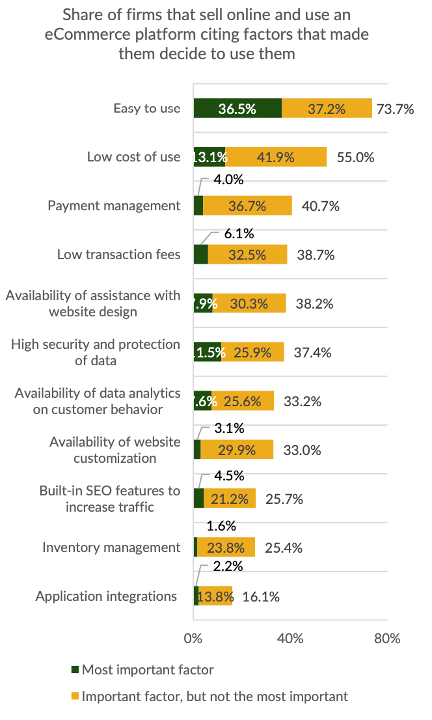
An online presence is a must for any business today, and online sales require a platform that allows consumers to have an easy, quick and reliable shopping experience. But building your own platform is expensive and takes time, making it impossible for many small and medium-sized businesses (SMBs). That’s why SMBs quickly understood the role third-party eCommerce platforms such as Shopify, Squarespace or Wix could play in their online businesses.
About 85% of Main Street SMBs in the U.S. already run their online business through one of these platforms, as per PYMNTS Intelligence data. Embracing adoption of such platforms could speed up the expansion of firms in both domestic and global markets at affordable costs.
While deciding to use an eCommerce platform for the online sales is probably an easy choice for many businesses, choosing one specific platform over another can be hard. Finding the best option may depend on variables such as the size of the firm and the kinds of features it prefers.

These are some of the key data extracted from the report “Main Street Health Q4 2023: eCommerce Protects Main Street SMBs’ Bottom Line in a Cooling Market,” a PYMNTS Intelligence and Enigma collaboration, draws from a survey of 540 small and medium-sized businesses (SMBs) with brick-and-mortar shops in commercial districts across the United States. The survey provides insights into how these business owners are approaching the challenges and opportunities associated with the increasing digital transformation. Industries analyzed in the research include construction and utilities, retail trade, professional services, consumer services and hospitality.
While high-revenue Main Street SMBs leverage more than one eCommerce platform to strengthen their online presence and expand their market reach, most of the firms reviewed use only one. Shopify and Squarespace are the most popular platforms among Main Street SMBs. Seven out of 10 firms surveyed cite one of them as their most used platform. The combination of versatility, ease of use, and the possibility to customize the shopping site at affordable prices are the rationale behind their popularity.
Lagging at a far distance, we find Wix, a digital platform that is the preferred option for 12% of firms, followed by WooCommerce and Big Commerce, with 5% and 4% of Main Street firms using them respectively.

Looking at the differences across industries, the report reveals that most retailers turn to Shopify to manage their online sales, and construction and utilities companies primarily choose Squarespace. Low-revenue firms are more likely to operate with Wix as this is one of the least expensive options.
The research also reveals that eCommerce platform preferences vary across industries and sizes. For instance, high-revenue Main Street SMBs demand more features of eCommerce platforms, while ease of use and low cost are enough for the average firm.
Digital commerce platforms are expanding their services beyond helping businesses build and manage online stores. One of the areas in which they are enhancing their features is in payment processing. To that end, leading digital commerce platforms are processing merchant payments in-house, demonstrating their commitment to becoming full-fledged payment providers. This approach allows platforms to have greater control over the payment process and offer seamless payment experiences to merchants and customers.
On the other hand, some major platforms are leveraging partnerships to provide payment solutions. These partnerships enable platforms to leverage the expertise of established payment providers while focusing on their core competencies. By partnering with payment solutions providers, digital commerce platforms can offer a wide range of payment options to merchants and enhance customer satisfaction. As these platforms expand their services to include payment solutions, they enhance merchant relationships and generate additional revenue streams.